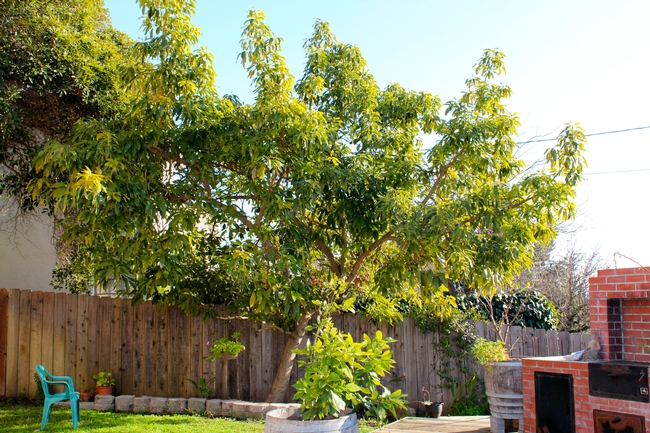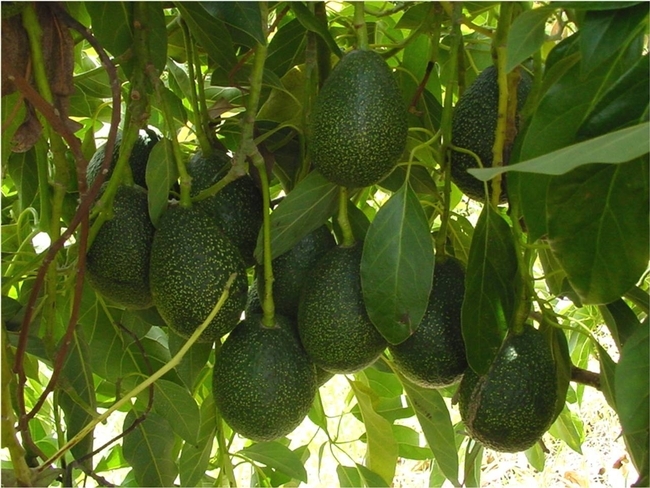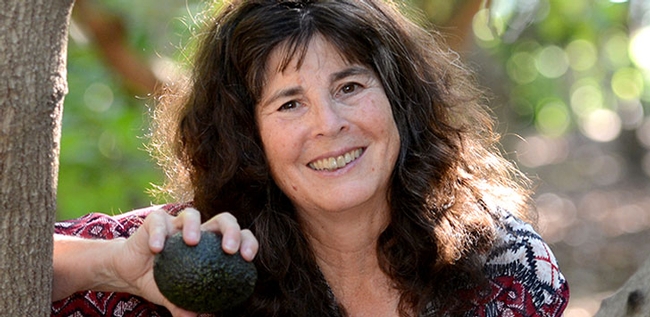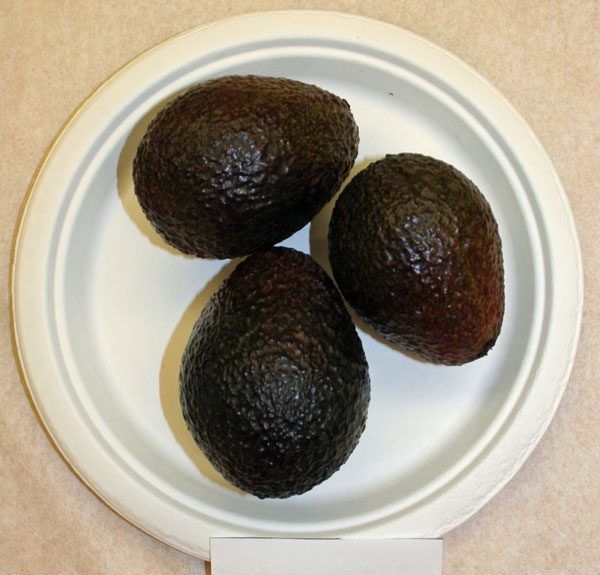Posts Tagged: avocados
Avocado tasters are wrapping up a their work at UC sensory lab
A group of trained and dedicated volunteers have been tasting avocado samples at the UC Kearney Agricultural Research and Extension Center in Parlier to determine whether the GEM avocado variety can stand up to the tried-and-true Hass in grocery stores, reported Dale Yurong on ABC 30 Action News.
Yurong visited the sensory lab at Kearney where nine tasters have been meeting for months to help inform UC and USDA research that may enable commercial production of avocados in the San Joaquin Valley, an area believed to be unsuitable because of hot summers and cold winters.
The panellists identify avocado characteristics like nutty, stringy and buttery. "You're getting into the texture, you're getting into a lot of different nuances of flavor," said taster Shannon Aguilar.
GEM avocados grow on smaller trees than Hass and GEM has a tear-drop shape, while Hass is more pear-shaped. But the real test will be comparable flavor and tolerance to valley conditions.
"We believe it has a little more heat tolerance and a little more cold tolerance," said UC Cooperative Extension specialist Mary Lu Arpaia.
The GEM may give local farmers a new crop option. One has already planted two acres of GEM.
"It's something that we probably need in this area. Something we can do and we wouldn't have to import it from other parts of the country or the world," said Marvin Flores, environmental health and safety specialist at Kearney and a member of the avocado taste panel.
UC researchers look to expand California avocado production
California avocados are the best in the world. So says downtown restaurant manager Daniel Avalos in a Valley Public Radio story by reporter Ezra David Romero.
The fact that they currently thrive only on a small swath of coastal Southern California is being challenged by UC Cooperative Extension specialist Mary Lu Arpaia. She is on a mission to find avocado varieties that withstand the hot summers and cold winters of the San Joaquin Valley, where irrigation water and crop land are more abundant and cheaper.
She hopes to find avocado varieties that ripen at various times of year, and varieties that might be an alternative crop for citrus growers should huanglongbing, a disease that has devastated the Florida citrus crop, take hold in Central California.
"There's a void of California fruit on the market in the months of November, December and actually early January," Arpaia said. "So if we can find different selections that maybe are unique that fit into that window, then we help the entire California avocado industry."
Romero visited the UC Lindcove Research and Extension Center to see the trees in Arpaia's study. Currently, the vast majority of California avocados are the Hass variety. The goal is to breed varieties with similar eating quality that grow to a moderate height and have high yield. One potential that is already being produced by nurseries is called "gem."
"This is gem," said Eric Focht, a staff research associate in Arpaia's lab. "You can see it's a little more oval or egg shaped than Hass. It has the speckling on the skin. Now as this ripens, it will turn dark and a lot of times the speckled lenticels with get a yellow kind of golden color it it."
Another promising variety is called "lunchbox" because of its small size. According to Focht, it "just falls out of the skin." Arpaia said, "It makes wonderful guacamole and I found, with a non-replicated test in my refrigerator, the fruit doesn't brown."
Arpaia's favorite guacamole recipe is featured at the end of the story on the KVPR website.
High-density planting of avocados boosts yield
The California avocado industry is getting much-needed hope from results of a UC Agriculture and Natural Resources (UC ANR) study on high-density planting, reported Lesley McClurg on Capital Public Radio. One farmer featured in her report said, because of the drought, he is paying $1,600 per acre-foot for water, an all-time high.
Gary Bender, an advisor with UC ANR Cooperative Extension in San Diego County, believes that increasing per-acre yield will help farmers stay in business.
“We've been growing avocados wrong all these years and we're finally starting to figure it out," Bender said.
He planted trees 10 feet apart in a research trial, instead of the standard 20 feet spacing. Instead of letting the trees grow tall, the standard practice, he pruned them regularly to keep the trees short and fat.
The study was a huge success, yielding nearly 13,000 pounds of Haas avocados per acre, McClurg reported. Usually farms in the area yield between 6,000 to 7,000 pounds per acre.
Frost Hardy Avocados for Solano Micro Climates
The avocado (Persea Americana) is sometimes described as the perfect food because of its digestibility and nutritional value, according to the California Master Gardener Handbook (2002).
Our backyard has an 30 year old (as yet unidentified) avocado tree which has been a real gem! It produces beautiful fruit and has proven to be frost hardy during a recent mid-January cold snap. Although we live in Vallejo, which is in Sunset’s zone 17 where frosts are relatively rare, Solano County has 3 additional zones: zones, 14, 15, and 9 in the Vacaville area. And you could have your own micro climate within those zones. For example a property on a hill or ridge top will have good “cold air drainage”, with temperatures a good 10-12 degrees F warmer than in lower lying areas.
According to UC Extension San Diego, the ‘Haas’ cultivar is the preferred one for Southern California coastal valley areas, which is where most of them are grown commercially. However, Mexican varieties (Persea americana drymifolia) can be grown in the Bay Area, as well as the “banana belts” of the San Joaquin Valley. Top Sunset Garden Book picks include ‘Fuerte’ (hardy to 27 degrees F), ‘Bacon, ‘Mexicola’ (very cold hardy to 20 degrees F), and ‘Zutano’ (hardy to 27 degrees F). I’m guessing our tree could be a ‘Bacon’, ‘Fuerte’ or ‘Zutano’, because the color of our fruit is dark to medium green, turning darker when ripe. It has a mild, nutlike flavor, and is quite good in a salad.
Fruit ripening varies with the cultivar. ‘Bacon’ and ‘Fuerte’ mature November to March, and ‘Mexicola’ matures August to September. Avocado varieties have flowers categorized as Type A or Type B, depending on the time of day they open and when pollen is released. Sunset recommends either planting a tree of each type, or buying a tree that has the opposite type grafted onto it, which is most likely the case with our tree, since we have only one.
Avocados need good drainage with occasional deep watering. Mulch should be applied 6 to 12” deep, but it needs to be kept away from the trunk. Although these trees are very susceptible to ‘Phytophthora’ root rot, the mulching and additional gypsum added to the soil, creates conditions which suppress this fungus.
So, experiment with this tropical treat. Although your harvest may not be of commercial quality, some of the hardiest varieties can be successfully grown.

Photos by Bud Veliquette

IMG 0847

IMG 0851

IMG 0846
Avocados
My sister-in-law has a seedling avocado tree in her backyard. It was given to her and my brother-in-law about 40 years ago by a good friend. When they received it as a gift, it was about two feet tall and you could see the avocado stone with the plant emerging from the middle. It was planted in their backyard about 10 feet away from the house and close to the side fence. Today this beautiful tree is about 55 feet tall, 20 inches in diameter and covers the side yard. They had no idea that it would ever get so large. Over the years the tree was fertilized with boxed ‘Avocado Food’ and kept trimmed away from the house, but received no other special treatment. The first fifteen years the tree had no fruit, but was enjoyed for the shade it provided. Then avocados began appearing. The avocados are thin skinned, creamy like butter and delicious. They are green on the tree and turn black when ready to harvest. This year there were so many avocados (they grew like grapes, and were as large as a fist) that we were overwhelmed. My son from Sacramento (Monkey-Man) came down three separate days and climbed the tree, spending hours picking and filling grocery bags with fruit. My sister-in-law’s garage was wall-to- wall with bags full of avocados. We estimated 400 pounds total. They were gladly shared with family, friends, neighbors, church members and anyone walking by the house. This was an exceptional year, but if the tree performs as it has in the past, next year should be a lighter bearing year. We’ll see!
Here’s how to start your own seedling avocado tree
Remove the seed from a store purchased avocado without damaging it. Soak in water for 10 minutes, and then clean the remaining fruit off without removing the brown skin on the seed (the seed cover). The top of the seed is the pointed end and the rounded end is the bottom. Push three or four toothpicks at equal intervals into the side of the seed, about 2/3 of the way down from the top. The toothpicks will support the seed as it sits on top of a cup of water with its blunt end submerged. Keep the seed warm, about 65 degrees, in a bright location out of direct sunlight, making sure the bottom third stays under water until you are ready to transplant. Change water often. BE PATIENT. It takes awhile for roots to form and longer for a shoot to appear. When a shoot develops and grows to 6 inches, it is ready to transplant into a 4 inch container. In several months transplant again into a larger pot and move outdoors to a sunny location. Feed with soluble houseplant fertilizer and pinch the growing tips occasionally to keep the tree bushy. When planting in the garden, imagine this tree 50 to 60 feet tall in years ahead and place it accordingly. You may be fortunate in future years to have delicious fruit. Remember seedlings can provide regular sized fruit, dwarf sized fruit or no fruit at all. Have fun with this propagation project and good luck.

Photo by Sharon Rico





